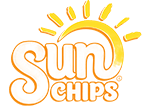Sun Chips
Sun Chips (officially styled as SunChips) is a brand of fried,[1] rippled, multigrain chips launched in 1991 and produced by Frito-Lay.
 Logo introduced for SunChips in 2016. | |
| Product type | Chips |
|---|---|
| Owner | Old Dutch (for Frito-Lay) |
| Country | United States |
| Introduced | 1991 |
| Markets | Worldwide |
| Website | official website |
Flavors
Permanent flavors include original, Harvest Cheddar, French Onion, Sweet and Spicy BBQ, and Garden Salsa.[2] In 2016, two Veggie Harvest flavors were added, Farmhouse Ranch and Tomato, Basil and Cheese that include vegetables.[3] Limited edition flavors have included Cinnamon Crunch early in 2007 (the flavor is still produced as a seasonal item in the US, reappearing near the end of the year for the holidays), as well as Honey Graham and Apple 'n Caramel in 2009.[4]
Internationally, other flavors have been introduced such as bulgogi in South Korea.
Pork enzymes
In the past, some Frito-Lay brand seasoned products, including some flavors of Sun Chips, contained pork enzymes in addition to herbs, cheese, and other seasonings. Frito-Lay's web site[5] states that they use enzymes from pigs (porcine enzymes) in some of their seasoned snack products to develop "unique flavors". The presence of pig-derived ingredients made them haram (forbidden) for Muslims, not kosher for Jews, and not vegetarian. As of April 5, 2011, Frito-Lay's online list "U.S. Products Made Without Pig (Porcine) Enzymes" catalogs nine flavors of Sun Chips "made and distributed in the U.S." that do not contain porcine enzymes.[5]
Compostable bags
In April 2008, Frito Lay introduced compostable packaging for the SunChips product line.[6] The bag is made of plant-based material. It will break down within 14 weeks in a hot, active compost pile.[7]
Noise complaints
In October 2010, Frito-Lay stated that the compostable package would be pulled back in the United States. The bag created excessive noise, which prompted Facebook groups and complaints.[8] In response to various complaints, Frito Lay announced that they would only use the compostable bag for original flavor chips from the SunChips US line moving forward. The other US flavors will use traditional SunChips packaging.[6]
Second attempt
On February 24, 2011, Frito Lay announced that they were releasing a new, quieter biodegradable bag starting with the Original Sun Chip brand.[9] Closely resembling traditional bags, the compostable packaging uses adhesives sandwiched between the outer and inner layers of the bag to substantially reduce the excessive noise.[10] Current bags are not labeled as compostable, as of 2015.
Popularity
Parent corporation PepsiCo has reported that sales of SunChips have declined by double-digit percentages annually since 2011.[11][12]
References
- Frito-Lay North America, Inc. "Frito-Lay: Baked VS. Fried". Archived from the original on 15 Oct 2008. Retrieved 31 March 2012.
- Hooper, Michael (November 20, 2006). "Frito Lay to expand, add 50 jobs". The Topeka Capital-Journal. Retrieved 2016-05-04.
- "What can Pepsico's Q2 results tell us on the savory snacks market?". Potato Pro. 11 July 2016.
- "Hitting the Shelves - April 2007".
- "U.S. Products Made Without Pig (Porcine) Enzymes". Archived from the original on 2013-01-16. Retrieved 2016-05-04.
- Fredrix, Emily. "Hush! Frito-Lay to Pull Most Noisy SunChips Bags". Associated Press. Retrieved 25 August 2011.
- "Why make a better bag?". Frito Lay North America Inc. Archived from the original on 2009-04-27. Retrieved August 4, 2009.
- Vranica, Suzanne (6 October 2010). "Sun Chips Bag to Lose Its Crunch". The Wall Street Journal. Retrieved 25 August 2011.
- "SunChips Silences Its Earsplitting Bio-Bag". fastcompany.com. 24 February 2011. Retrieved 24 February 2011.
- "SunChips". Frito Lay.
- "PepsiCo, Inc. Form 10-K for the fiscal year ended December 29, 2012". PepsiCo, Inc. p. 54. Retrieved February 16, 2015.
- "PepsiCo, Inc. Form 10-K for the fiscal year ended December 27, 2014". PepsiCo, Inc. p. 57. Retrieved February 16, 2015.